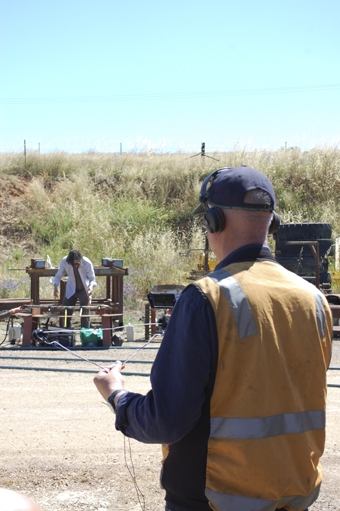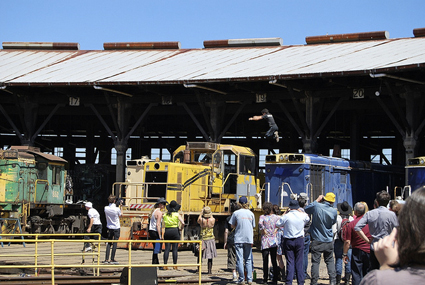railroad transformations
bruce mowson, rolling stock, junee

Chris Watson, Rolling Stock
photo Public Assembly
Chris Watson, Rolling Stock
ON A TOASTY SATURDAY AFTERNOON, SEVERAL HUNDRED PEOPLE GATHERED FOR THE ROLLING STOCK EXTRAVAGANZA, FEATURING INSTALLATION AND PERFORMANCE WORKS AT THE JUNEE RAILWAY ROUNDHOUSE AND ON AN HISTORIC TRAIN RIDE.
The project had a site-specific emphasis, building on the evocative architecture and machinery of the train and Roundhouse and upon the phenomenon by which sound can overlay and transform the visual environment. Dave Noyze and Garry Bradbury made a hugely entertaining work of the Roundhouse turntable, a sort of huge record platter on which train carriages can be spun and driven into the workshops. The rotation of the platter caused a fearsome clamour as tons of metal and concrete ground together. The artists made a subtle yet savvy intervention, adding their own sounds but largely relying on the spectacle of the machine itself. The duo’s work harked back to the futurist enthusiasm for mechanical noise, with perhaps less Italian aristocratic arrogance and more rustily laconic bogan self-satisfaction, laced with snotty Industrial lip-curl. One can only hope that they’ll be let loose on another edifice, perhaps the Sydney Harbour Bridge or the rotating restaurant atop Sydney’s Centrepoint Tower.
Among other works, a local parkour crew braved the sun to provide some hi-NRG action, vaulting carriages and locos, eliciting visceral sensations in the audience as they flew above the concrete, evoking the spirit of concrete-clad outer Paris. Joel Stern and Andrew McLellan drummed and thrummed out a two-person, rural-NSW style gamelan sound using junk that was lying about (presumably waiting for such a performance opportunity), creating moments of entrancing musical pleasure.

Parkour, Rolling Stock
photo Jennifer Teo
Parkour, Rolling Stock
Following the Roundhouse smorgasbord of sounds came a train journey to Cootamundra and back. Like the Roundhouse, the historic train needs barely the slightest breath from the artist, being a novelty in its own right. Infusing the artistic proceedings was the social scenario created by the train, where urban and regional were thrown together in the booths of the antique rail carriages. In one such encounter, my listening to the performance of UK artist Chris Watson co-existed with a woman’s story of her daughter’s suicide following a grand-daughter’s premature death. I could not ask the woman to stop, not least because the teller hadn’t noticed there was a performance to hear. Such is art as it emerges from its trench and sticks its head into the terrain of life.
Chris Watson’s polished and sophisticated work took the form of El Tren Fantasma (The Ghost Train), a sound design recreating another train journey. It is composed from recordings made by the composer for the Great Train Journeys TV series in 1998, documenting the last coast-to-coast passenger service of the Mexican State railway system prior to its closure due to privatisation. Watson’s strength is the masterful fidelity of his recordings with which he skilfully composes his simulations. The outstanding feature of the work was his manipulation of one’s sense of time, transforming a multi-day journey into a single experience. In Junee the work reads as an imaginative fancy, layering exotic Mexico over exotic rural NSW. Given the site-specific emphasis of the festival, one hopes Watson made some local recordings and might re-present them in situ in the future. El Tren Fantasma is soon to be released on CD.
Also working with the sound of the train was Sydney media artist Shannon O’Neill, whose Locomentum foregrounded the iconic phenomenon of rail rhythms. A subtle piece inviting close listening, it blended the live and recorded sounds to create a minimalist ‘phase space’ where the already hypnotic rhythm of the train is blurred by a recorded doppelganger. This innocuous play of rhythm opens up reflection on the auditory pleasure of trains, wherein the regularity of the sound is compelling. Trains, like ships, can have a particular pleasure, stemming from their combination of high-speed motion and hotel-style living. They have a lulling rhythm, but also the potential for humungous collision, injury and death. I’m reminded of the lullaby “rock-a-bye baby in the tree top; when the wind blows, the cradle will rock; when the bough breaks the cradle will fall”; it’s a rhyme that on reflection seems an odd one to relax a child.
Other works on the train included Sleeper Carriage by Noyze and Bradbury. Installed in a sleeper carriage, and sounding much like an Alan Lamb work, it offered a rich seam of electronic sound to be listened to from the privacy and comfort of a bed, albeit with the spoken accompaniment of artists and punters who took respite and refreshments in the compartments and perhaps didn’t realise or care how far their conversations carried. In another carriage the PVI collective presented a work based on local political issues via the medium of a tug-of-war. Numerous other works were presented, with details available at http://rollingstock.weebly.com/.
Art maverick Sarah Last, who describes herself as an artist rather than curator, organised Rolling Stock. Her work in the Unsound Festivals, the Wagga Space Program, The Wired Lab and a variety of other activities is noteworthy. There are few curators working in sound in Australia, and even fewer curators working with sound site-specifically. In her plenary address to the 2010 Regional Arts Australia conference, Last outlined her interest in breaking down artist-audience divisions and encouraging the creative and active participation of local communities in art projects. The audience at Rolling Stock didn’t actually get their hands dirty with noise making, but the presence of more non-practitioners than practitioners in the audience is a step in the right direction. While some of the works showed depth of engagement with the site and were created in cooperation with community, the degree to which audiences were challenged and their perception developed was less clear, perhaps by virtue of the very private nature of the art experience.
To my ear, the most amazing sound of the weekend was the soundscape of insects, animals and air movement heard at midnight in a quiet spot 10 kilometres from town—an immersive ecosystem of interlocking patterns, layers, events and narratives. Recording technology and artists will always be hard pressed to compete with the wonders that the world serves up. For me this is the strongest offering of sound culture: events like Rolling Stock induce heightened awareness of a realm of aesthetic information that is familiar to many practitioners but, I suspect, lost on people at large.
Rolling Stock was driven by Sarah Last’s pursuit of her ideas and aims and her ongoing relationships with particular spaces and communities such as the railway works and the people of Junee. These are long-term projects, embedded in her own life in a family farm that houses The Wired Lab. It will be interesting to see how these relationships develop and how Last’s objectives play out.
–
Wired Lab, Rolling Stock, curator Sarah Last, Junee, NSW, Nov 20, 2010; http://rollingstock.weebly.com/; artist residencies, Nov 12-19
RealTime issue #101 Feb-March 2011 pg. 53






